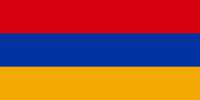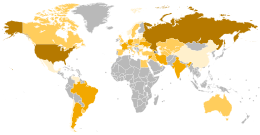
Back Аерманцәа Abkhazian Armene Afrikaans Armenios AN أرمن Arabic ܥܡܐ ܐܪܡܢܝܐ ARC ارمن ARZ Armenios AST Армениял AV Ermənilər Azerbaijani ارمنیلر AZB
Armenians are an ethnic group and nation native to the Armenian highlands of West Asia.[1][2][3] Armenians are the main population of the Republic of Armenia. They were the main population of the unrecognized Republic of Artsakh until the Armenians of Nagorno-Narabakh were ethnically cleansed. There is a diaspora of around five million people of full or partial Armenian ancestry living outside modern Armenia. The largest Armenian populations today are in Russia, the United States, France, Georgia, Iran, Germany, Ukraine, Lebanon, Brazil, Syria, and Turkey. The present-day Armenian diaspora was mainly a result of the Armenian genocide with the exceptions of Iran, former Soviet states, and parts of the Levant.[4]

2nd row: Mesrop Mashtots • Vardan Mamikonian • Movses Khorenatsi • Anania Shirakatsi • Grigor Narekatsi
3rd row: Levon II • Toros Roslin • Momik • Sayat Nova • Khachatur Abovyan
4th row: Ivan Aivazovsky • Andranik Ozanyan • Hovhannes Tumanyan • Komitas • Mkrtich Khrimian
5th row: Tovmas Nazarbekian • Aram Manukian • Yeghishe Charents • Arshile Gorky • Gaia Gai
6th row: Artem Mikoyan • Ivan Bagramyan • Aram Khachaturian • Viktor Ambartsumyan • Tigran Petrosian
7th row: Martiros Saryan • Kirk Kerkorian • Sergei Parajanov • William Saroyan • Charles Aznavour
8th row: Vazgen I • Karen Demirchyan and Vazgen Sargsyan • Cher • Monte Melkonyan • Serj Tankian
They speak Armenian which is an Indo-European language unique in that language family.[2][5] It has two mutually intelligible spoken and written forms. Eastern Armenian, today is spoken mainly in Armenia, Artsakh, Iran, and the former Soviet republics. Western Armenian, is used in Western Armenia and, after the Armenian genocide, primarily in the Armenian diasporan communities. The unique Armenian alphabet was invented in 405 AD by Mesrop Mashtots.
Most Armenians are in the Armenian Apostolic Church, a non-Chalcedonian Christian church. It is the world's oldest national church. Christianity began to spread in Armenia soon after the death of Jesus, due to the efforts of two of his apostles, St. Thaddeus and St. Bartholomew.[6] In the early 4th century, the Kingdom of Armenia was the first state to adopt Christianity as a state religion,[7] followed by the first pilgrimages to the Holy Land where a community established the Armenian Quarter of Old Jerusalem.[8][9]
Armenian: Հայեր, romanized: Hayer | |
|---|---|
 Flag of Armenia | |
| Total population | |
c. 7–8 million[10] | |
| Regions with significant populations | |
| Modern Armenian diaspora: | |
| 946,172–2,500,000[13][14] | |
| 485,970–1,500,000[15][14] | |
| 500,000–600,000[14] | |
| 99,900–130,000[16][14] | |
| 63,810–65,000[17][14] | |
| 50,000–60,000[14] | |
| 92,000[14] | |
| 45,000–80,000[14] | |
| 20,000[18][14] | |
| 16,723[19] | |
| 35,000–40,000[14] | |
| 70,000[14] | |
| 70,000–80,000[14] | |
| Armenian minorities in Middle East: | |
| 70,000–80,000[14] | |
| 65,000–70,000[14] | |
| 50,000–70,000[20][21][14] | |
| 70,000–80,000[14] | |
| Armenian minorities in Caucasus: | |
| 168,100–400,000[22][14] 41,875[23] | |
| Languages | |
| Armenian | |
| Religion | |
(Armenian Apostolic Church) | |
| Related ethnic groups | |
| Hayhurum[a] | |
- ↑ Hewsen, Robert H. "The Geography of Armenia" in The Armenian People From Ancient to Modern Times Volume I: The Dynastic Periods: From Antiquity to the Fourteenth Century. Richard G. Hovannisian (ed.) New York: St. Martin's Press, 1997, pp. 1–17
- ↑ 2.0 2.1 "Armenian Rarities Collection". www.loc.gov. Washington, D.C.: Library of Congress. 2020. Archived from the original on 7 March 2023. Retrieved 27 March 2023.
The lands of the Armenians were for millennia located in Eastern Anatolia, on the Armenian Highlands, and into the Caucasus Mountain range. First mentioned by a Greek and a Persian source in the 6th century BC, modern DNA studies have shown that the people themselves had already been in place for many millennia. The people the world know as Armenians call themselves Hay and their country Hayots' ashkharh–the land of the Armenians, today known as Hayastan. Their language, Hayeren (Armenian) is a separate and unique branch of the Indo-European linguistic family tree. A spoken language until Christianity became the state religion in 314 AD, a unique alphabet was created for it in 407, both for the propagation of the new faith and to avoid assimilation into the Persian literary world.
- ↑ "Armenia: Ancient and premodern Armenia". Encyclopædia Britannica Online. Encyclopædia Britannica, Inc. Archived from the original on 26 April 2019. Retrieved 17 July 2018.
The Armenians, an Indo-European people, first appear in history shortly after the end of the 7th century BCE[, d]riving some of the ancient population to the east of Mount Ararat [...]
- ↑ Richard G. Hovannisian, The Armenian people from ancient to modern times: the fifteenth century to the twentieth century, Volume 2, p. 421, Palgrave Macmillan, 1997.
- ↑ "Armenian (people) | Description, Culture, History, & Facts". Archived from the original on 26 April 2019. Retrieved 5 September 2018.
- ↑ see Hastings, Adrian (2000). A World History of Christianity. Wm. B. Eerdmans Publishing. p. 289. ISBN 978-0-8028-4875-8.
- ↑ "Armenia first nation to adopt Christianity as a state religion". Archived from the original on 6 January 2011. Retrieved 2007-02-27.
- ↑ Cite error: The named reference
Jewish Virtual Librarywas used but no text was provided for refs named (see the help page). - ↑ Davis, Joyce M. (July 1992). "Jerusalem's Armenian Quarter". ONE Magazine. Catholic Near East Welfare Association. Archived from the original on 21 June 2023. Retrieved 2023-06-21.
- ↑ Cite error: The named reference
NNwas used but no text was provided for refs named (see the help page). - ↑ "2011 Census Results" (PDF). National Statistical Service of Republic of Armenia. p. 144.
- ↑ "Աղյուսակ 5.4 Բնակչությունը (քաղաքային, գյուղական) ըստ ազգության, սեռի և կրոնական դավանանքի [Table 5.4: Population (urban, rural) by ethnicity, gender and religious affiliation]" (PDF). Artsakh Republic National Statistical Service. Archived from the original (PDF) on 2019-04-03. Retrieved 2022-11-30.
- ↑ "Том 5. «Национальный состав и владение языками». Таблица 1. Национальный состав населения ["Volume 5. «National composition and language proficiency». Table 1. National composition of the population"]. (PDF). Federal State Statistics Service of Russia. 2021.
- ↑ 14.00 14.01 14.02 14.03 14.04 14.05 14.06 14.07 14.08 14.09 14.10 14.11 14.12 14.13 14.14 14.15 14.16 Ayvazyan 2012, p. 914.
- ↑ "2017 American Community Survey 1-Year Estimates" Archived 2020-02-13 at Archive.today. (PDF). United States Census Bureau. 2017.
- ↑ "National composition of population". State Statistics Service of Ukraine. 2001.
- ↑ "Ethnic Origin, both sexes, age (total), Canada, 2016 Census". Statistics Canada. 2016.
- ↑ "Armenian High Commissioner for Diaspora Affairs meets Uruguay's FM". Armenpress. 15 August 2019, "Uruguay's Minister of Foreign Affairs Rodolfo Nin Novoa emphasized the Armenians' role in his country and noted that according to their estimates 20,000 Armenians live in Uruguay currently."
- ↑ "The People of Australia – Statistics from the 2011 Census" (PDF). Australian Government. Archived from the original on 2014-07-14. Retrieved 2022-04-15.
{{cite web}}: CS1 maint: bot: original URL status unknown (link) - ↑ Turay, Anna. "Tarihte Ermeniler". Bolsohays: Istanbul Armenians. Archived from the original on 6 December 2006. Retrieved 2007-01-04.
- ↑ Khojoyan, Sara (16 October 2009). "Armenian in Istanbul: Diaspora in Turkey welcomes the setting of relations and waits more steps from both countries". ArmeniaNow.com. Archived from the original on 1 January 2017. Retrieved 5 January 2013.
- ↑ "2014 General Population Census" (PDF). National Statistics Office of Georgia. 2016. Archived from the original on 2017-10-10. Retrieved 2022-12-05.
{{cite web}}: CS1 maint: bot: original URL status unknown (link) - ↑ "2015 год - Национальный состав наличного населения [2015 - National composition of the present population"]. Office of State Statistics of the Republic of Abkhazia. 2016.
<ref group=lower-alpha> tags or {{efn}} templates on this page, but the references will not show without a {{reflist|group=lower-alpha}} template or {{notelist}} template (see the help page).
© MMXXIII Rich X Search. We shall prevail. All rights reserved. Rich X Search